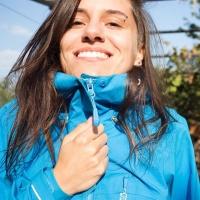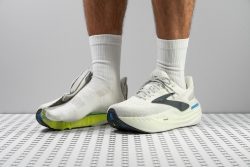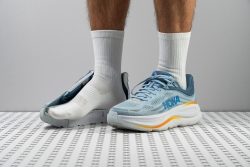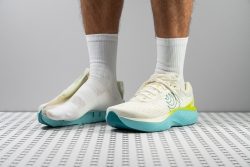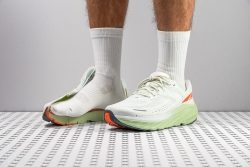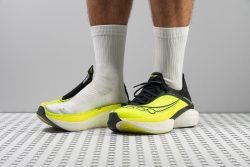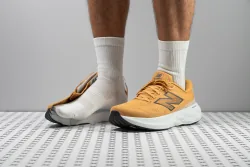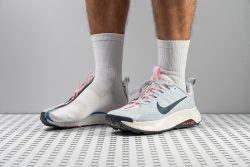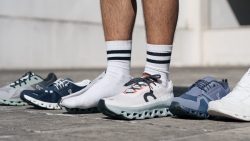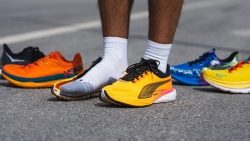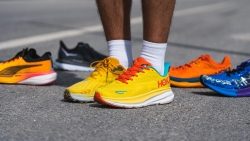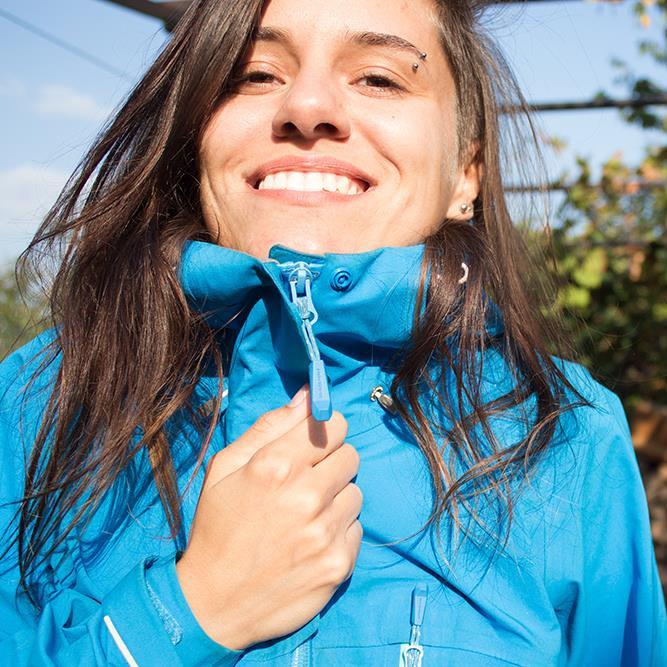7 Best Hallux Rigidus Running Shoes in 2025
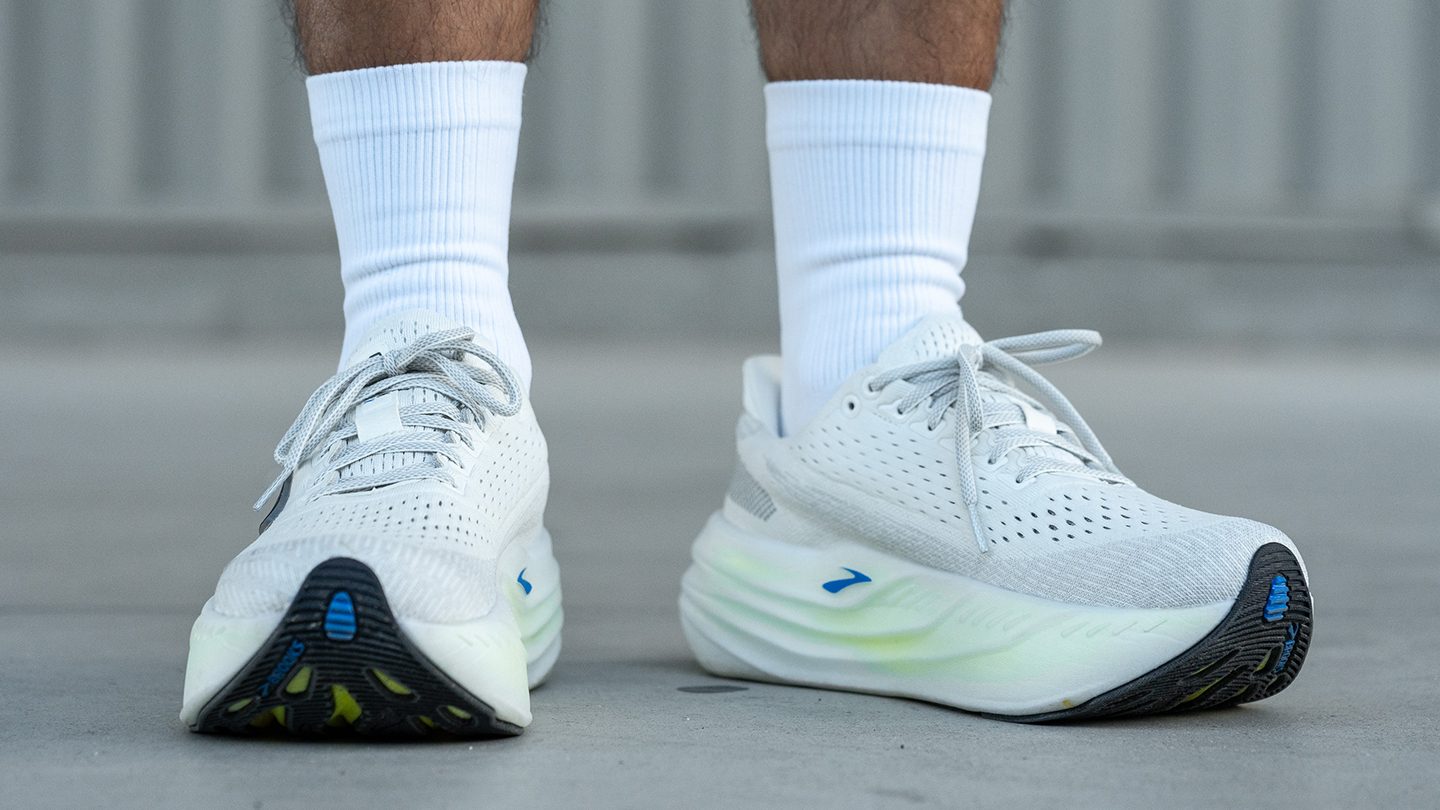
We buy shoes ourselves. We earn commissions when you buy through us, at no extra cost. Why trust us
Hallux rigidus or big toe arthritis usually starts with limited big toe motion (hallux limitus) and it progresses towards hallux rigidus, starting with Grade 1 to Grade 4. The sooner you start addressing this, the better the chances for recovery and avoiding surgical interventions.
In this guide, we offer an overview of running shoe features that matter the most when it comes to big toe pain and limited range of motion. We explain every feature and back it up with lab data. If you're in a hurry, we've highlighted our best picks in different categories! It's our version of the TL;DR.
How we test hallux rigidus running shoes
Every test that we perform in our lab is standardized and so is our full testing process. Every shoe is treated the same, no exceptions. No brand or any other entity has a say in what we write or which shoes are selected as top picks. We back everything up with lab data, scientific research, and our own experience.
This means that we buy the shoes with our own money, test them on the runs, and test them in the lab. We use different tools and machines to test energy return, traction, shock absorption, breathability, stiffness, durability, and the volume of the toebox. Our reviews are unbiased, and the lab data is comparable across shoes within the same category.
Best running shoes for hallux rigidus overall
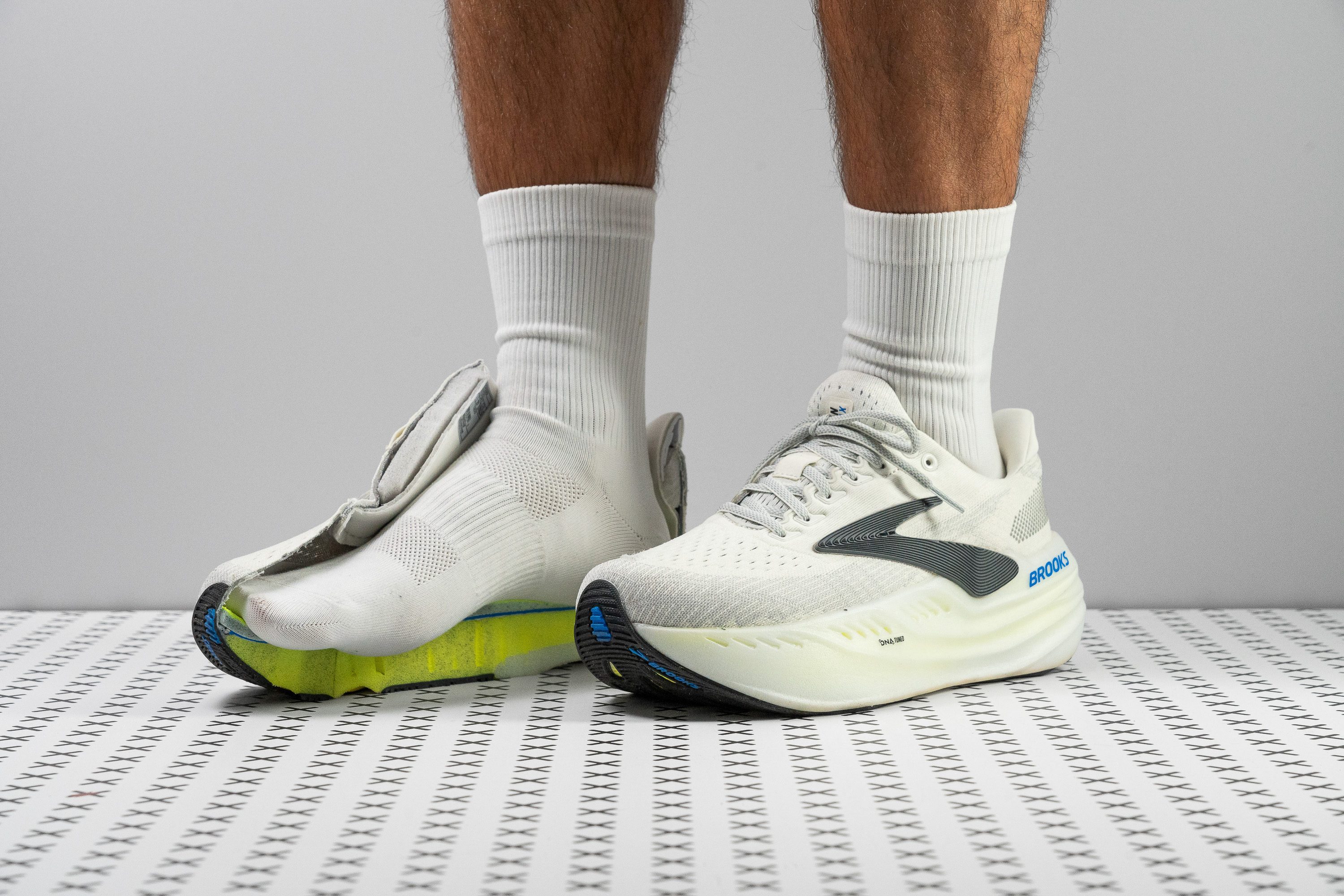

























































What makes it the best?
After miles of pounding the pavement with the Brooks Glycerin Max, we couldn’t deny its reliable support and lasting comfort. With its stiff and well-cushioned forefoot, we believe it’s the best hallux rigidus running shoe overall. In addition to its impressive shock absorption performance in the lab, it features a rocker sole and a spacious toe box—perfect for reducing pressure on the big toe.
The midsole feels stable, keeping our feet in place through its rigid structure. Our bend test validates it’s 22.8% stiffer than average. Additionally, it features a rocker that facilitates smooth forward transitions and reduces the effort required for toe-offs.
Based on our lab results, the Glycerin Max ensures our forefoot receives maximum protection through its thick 35.7 mm stack. It also impressed us with a shock absorption score of 148 SA, 16.5% better than average.
Our toes had plenty of room to breathe during our runs. Not only is the upper stretchy, it’s breathable too, confirmed by its 5/5 ventilation score in the lab. The toebox also offers lots of space, particularly its 28.8 mm vertical clearance.
However, the outsole has limited rubber coverage, which may impact its longevity. Runners seeking a durable running shoe should go for another pair.
Pros
- Massive impact dampening
- Luxurious yet breathable upper
- New DNA Tuned midsole
- Eye-catching look
- Surprisingly stable
- Can be used as a walking shoe
- Premium materials
Cons
- Too heavy
- Midsole lacks bounce
- Poor rubber coverage
- High price tag
Best hallux rigidus running shoes for narrower feet
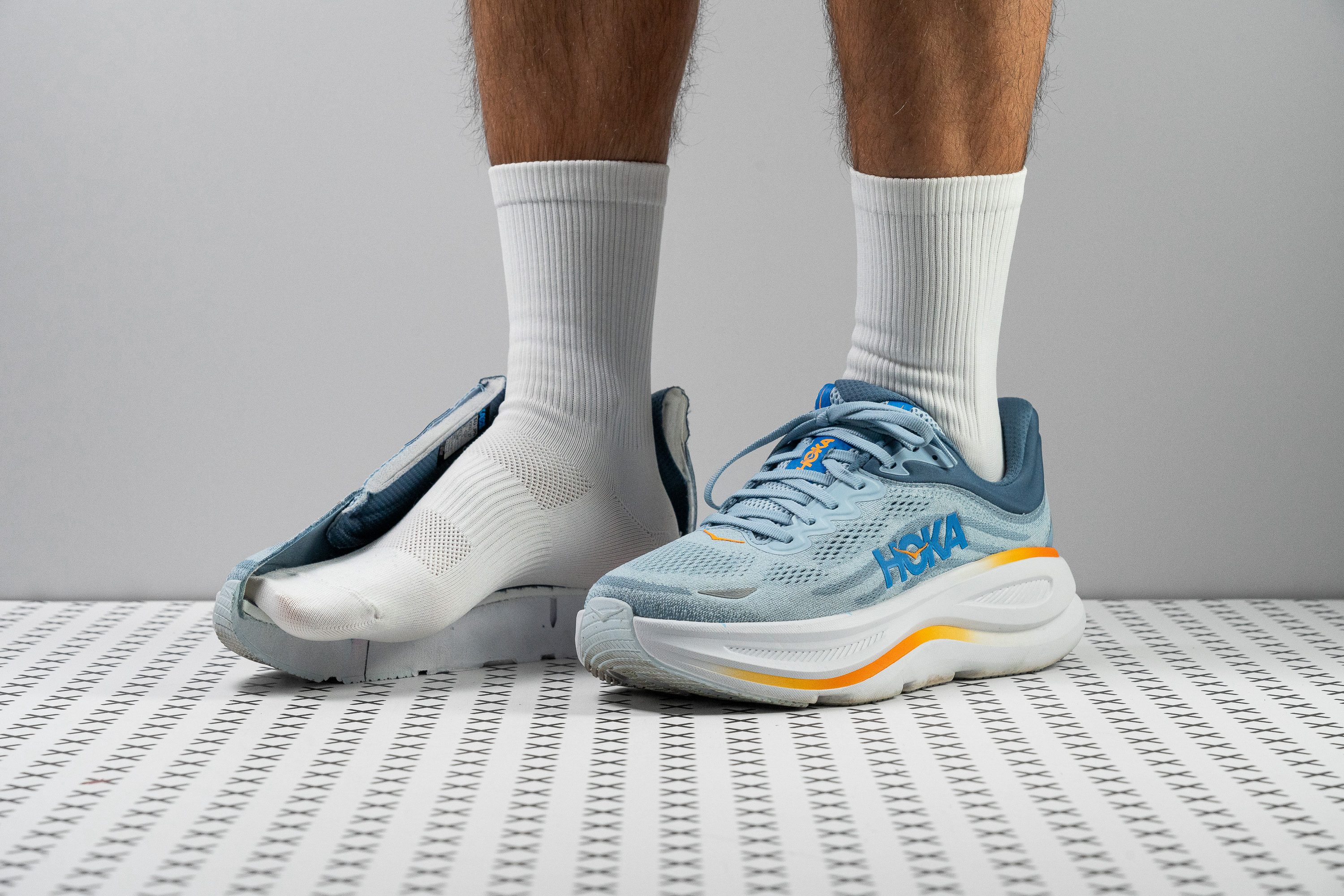

















































What makes it the best?
In our search for the best hallux rigidus running shoes, we found the Hoka Bondi 9 to be the perfect fit for those with narrow feet. According to our lab measurements, it offers a spacious room that is neither too narrow nor too wide, allowing for comfortable big toe clearance. We enjoyed the forefoot's reassuring support during our runs, which lab results confirm with a high stiffness score.
Using our caliper, we measured the shoe’s width at 94.1 mm, staying right below the 95.3 mm average while staying above the recommended minimum width for those with hallux rigidus (93.0 mm). This makes it comfortable enough for those with narrow feet without feeling like swimming inside the shoe.
We also measured the toebox height at a massive 29.6 mm. Being 8.4% taller than average, we had no pressure points on our big toe.
Even when pushing the pace, Bondi 9 supported our toes well so that they don’t have to do a lot of work. Our bend test shows it features a high stiffness score of 16.5N, 10.7% above average, which helps avoid excessive and unwanted movement. Plus, it features a moderate rocker that assists us in forward movement.
Unfortunately, Bondi 9 fails to impress us in the weight department. At 10.7 oz (303g), it’s 14.3% heavier than average. Those seeking a weightless ride should explore alternatives.
Pros
- Endless cushioning
- New supercritical EVA midsole
- Amazing step-in comfort
- Doubles as a walking shoe
- Stable for its height
- Built to last
- Excels at slow-and-steady paces
- Well-designed heel collar
- Lighter than v8
Cons
- Not for wide feet
- Still feels heavy and clunky underfoot
- Drop measurement differs from stated
- Non-gusseted tongue
Best hallux rigidus running shoes with a wide toebox
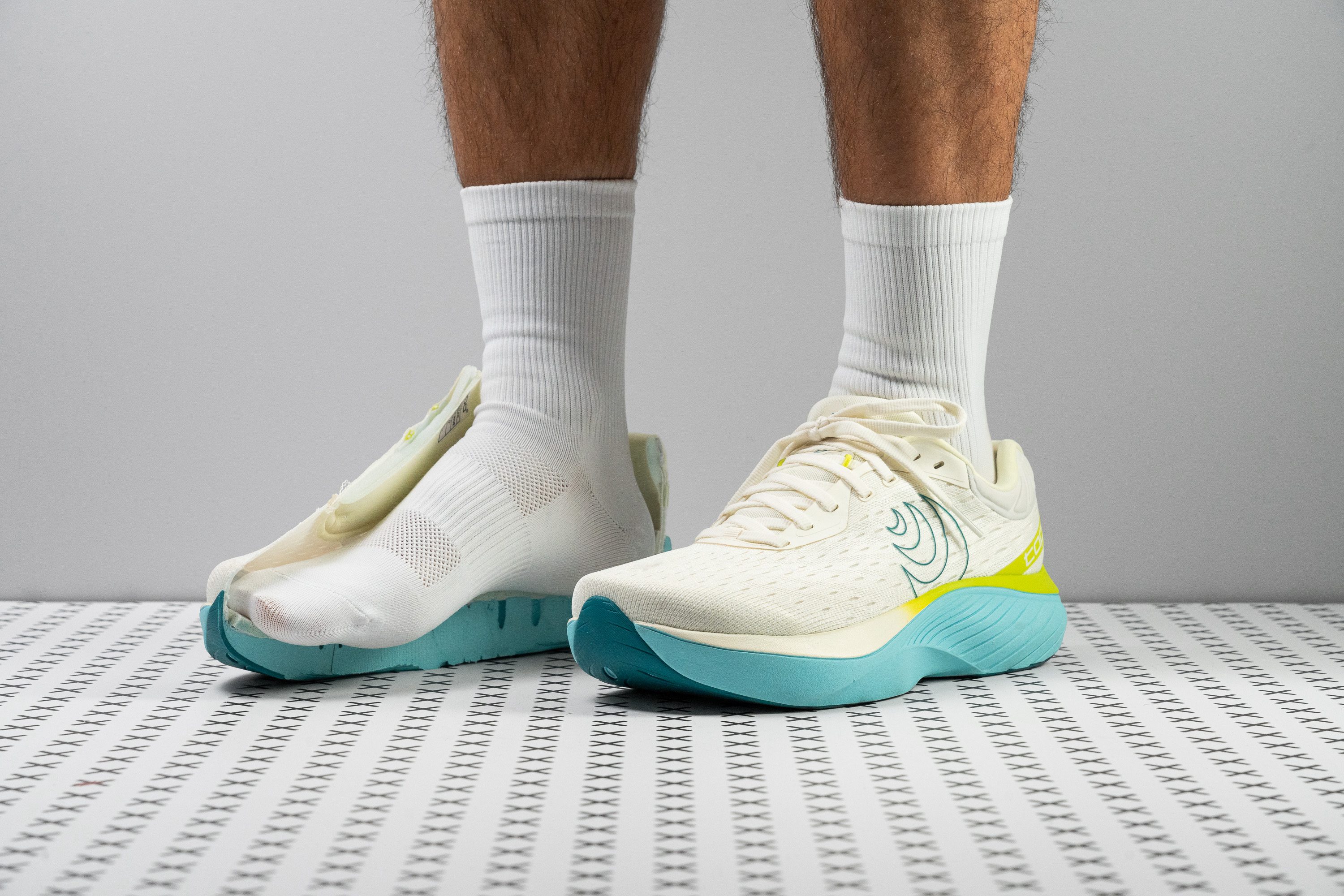















































What makes it the best?
The Topo Atmos ticks the boxes of what we’re looking for in hallux rigidus shoes, but it stands out most with the best wide toebox. Confirmed by lab results, it features a stiff forefoot and the brand’s signature anatomical toebox, offering generous room in terms of width and height and eliminating any unwanted pressure on our big toes.
When facing a condition like hallux rigidus, we want zero pressure on the big toe, and the Topo Atmos offers just that. Using our caliper, we measured the toebox at a very generous 85.0 mm, which is 11.5 mm wider than average! In terms of vertical clearance, we also had no worries with its above-average 29.8 mm height.
During our runs, the Topo Atmos felt pleasantly stable, which limits the unwanted movement of the big toe. In our bend test, we confirmed the shoe’s stiffness score of 15.1N meets the standard 15.0N rating we’re looking for in hallux rigidus shoes. It also resists any twisting with its high 5/5 torsional rigidity score, offering solid support to our feet.
Beneath our big toe lies a thick 32.5 mm forefoot cushion. Being 6.8 mm taller than average, we enjoyed much-needed impact protection. However, Atmos delivers a more traditional ride. Those seeking forward momentum should go for rockered shoes.
Pros
- Max-cushioned comfort
- Ultra-spacious toebox
- Stable ride
- Premium Ortholite footbed
- Midfoot-friendly geometry
- Lightweight for its huge size
- Great for easy long runs
- No heel slippage
Cons
- Lacks energy return
- Not for narrow-footed runners
- Could be a bit more flexible
Best zero-drop running shoes for hallux rigidus
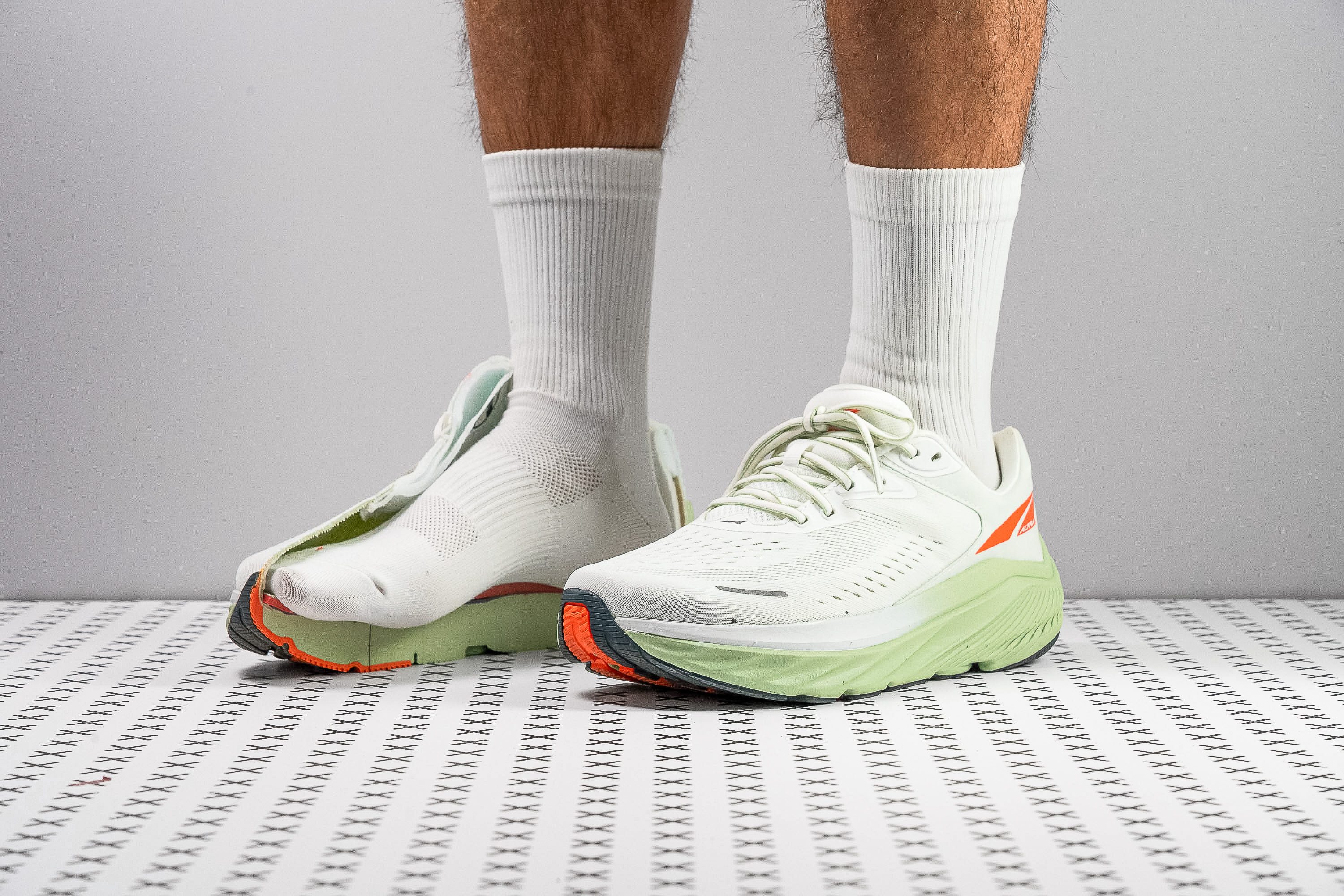



















































What makes it the best?
After logging mileage on the road and hours in the lab, we discovered the Altra VIA Olympus 2 is the best zero-drop hallux rigidus running shoe. It features a true zero drop without compromising comfort and support through its cushioned yet stiff forefoot. We enjoyed its roomy toebox that eliminates any unwanted big toe compression.
In the lab, we measured the drop at -0.2 mm, which takes some load off the forefoot since our weight is more evenly distributed. Though the drop is zero, the shoe features a generous 35.0 mm forefoot stack, keeping our feet well-protected from harsh landings.
The midsole features a slight rocker and a stiff forefoot that limits stress on our big toe. Our bend test confirms it’s 47.0% stiffer than average, preventing excess movement that may cause more pain.
The Altra FootShape offers unmatched comfort, exceeding the average in both height and width. Measuring the toebox width using out gel mold of the shoe's interiors, it boasts an impressive 81.7 mm width and a substantial 30.4 mm vertical clearance, ensuring we have more than enough breathing room.
Unfortunately, the shoe feels stuffy when the temperature rises. With a subpar breathability score, those seeking more ventilation should go for another pair.
Pros
- Incredibly roomy toebox
- Authentic zero-drop design
- Extremely cushy and soft midsole
- Superb all-around durability
- Cozy upper
- Remarkably stable
- Ideal for long runs
Cons
- Limited ventilation
- Tongue not gusseted
- Still a bit heavy
Best race running shoes for hallux rigidus
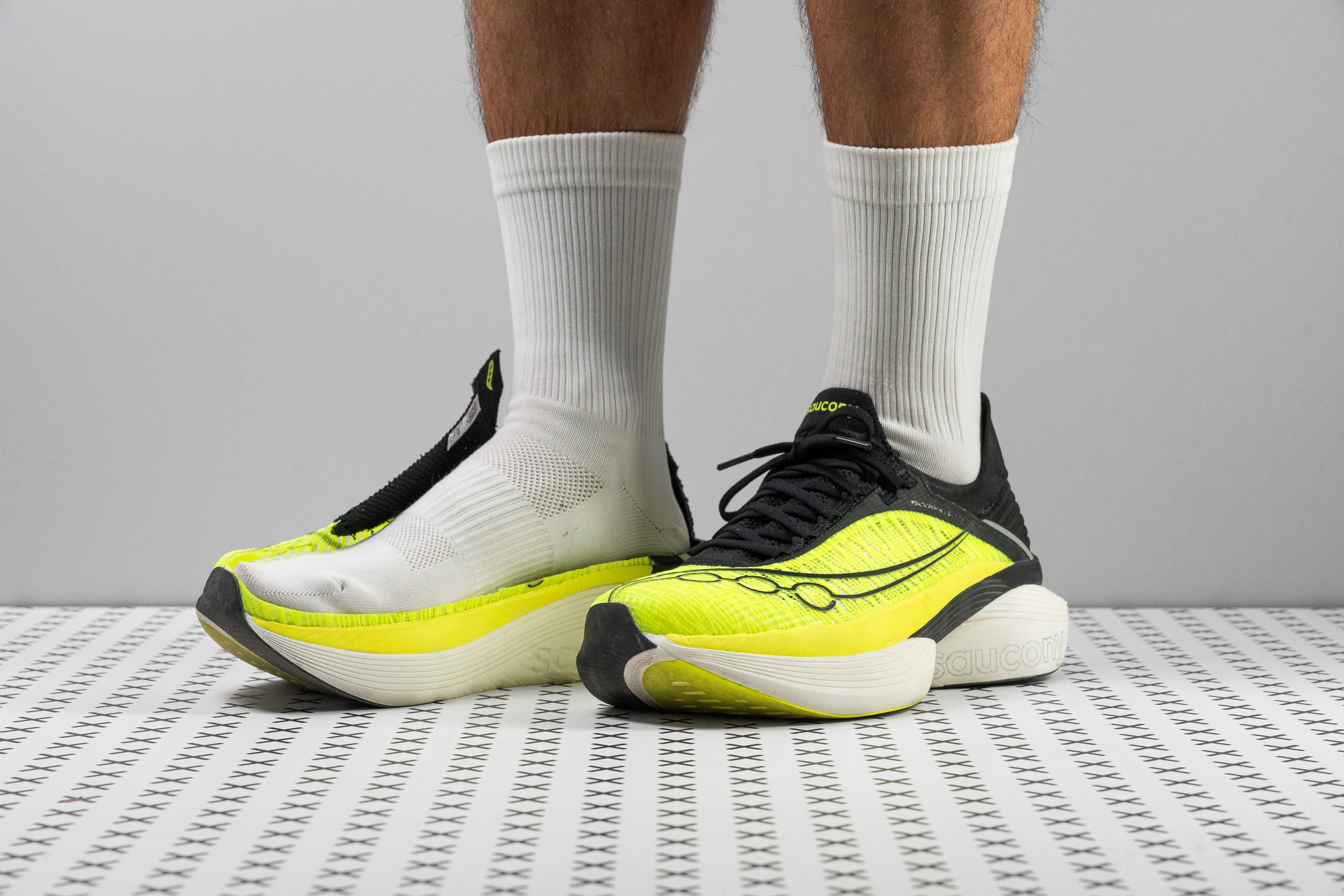















































What makes it the best?
The Saucony Endorphin Elite 2 offers exhilarating speed in a lightweight package, allowing us to soar to the finish line without discomfort. Multiple runs and lab tests confirm that its IncrediRUN foam and carbon plate deliver both support and energy return, while its toebox is accommodating despite the shoe’s overall streamlined build. Therefore, it’s our top race shoe for those with hallux rigidus.
Its airy sensation on foot is undeniable, and our scale validates its feathery 6.9 oz (197g) build. Being 25.7% below the average, it saves us tons of energy because it takes less effort to lift each foot and pick up the pace.
The spoon-shaped carbon plate does a great job of improving efficient leg turnover. It adds stiffness to the forefoot, which helps stabilize the big toe. Our bend test validates it’s 10.0% stiffer than the average running shoe.
Surprisingly, we measured the toebox to be spacious enough for those with hallux rigidus. The toebox width is 71.0 mm, while its height is an impressive 29.5 mm compared to the 27.3 mm average. These figures assure us we won’t have to deal with cramped toe space.
However, the shoe’s lack of stability elements demands good form. Those who need more support should skip this pair.
Pros
- Record-breaking energy return
- Ultra-plush foam
- Fantastic shock absorption
- Addictively bouncy and fun feel
- Ideal for the marathon distance
- Durable and breathable upper
- Improved lockdown with knit tongue
- Stack height maxes out the legal limit
- Explosive, forward-driving ride
Cons
- A touch heavy for being an elite supershoe
- Budget-crushing price
- Lateral stability is extremely bad
- Lacks specific support for heel strikers
Best forefoot-strike running shoes for hallux rigidus
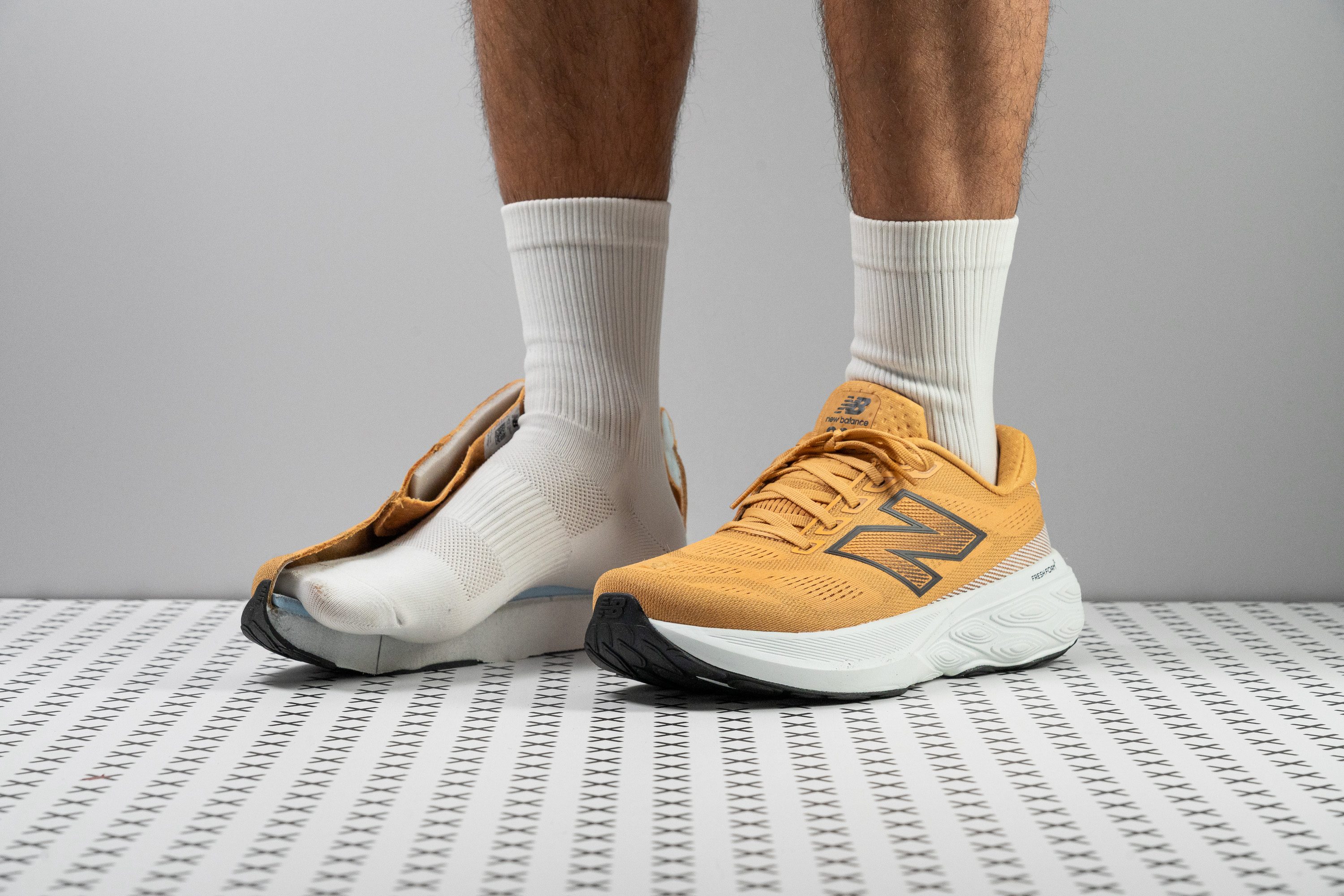













































What makes it the best?
Through countless hours on foot, we can attest to the New Balance Fresh Foam X 880 v15’s comfort and support. Our lab results show it features a low drop and a stiff and impact-protected midsole that makes it a perfect match for forefoot strikers dealing with hallux rigidus. It also features a spacious toebox that accommodates our big toe without any strain.
The shoe features a subtle incline that allows us to put less load on the front of our foot. With a precise measurement of 4.3 mm, we confirmed it favors forefoot strikers. We tested the cushion’s capacity to absorb shock, and the 880 v15 performed 9.6% better than average, avoiding any additional pain on our big toes.
880 v15 offers a highly supportive ride through its stiff structure. In our bend test, it took 28.9% more effort to bend the shoe to 30 degrees. This score suggests our feet will feel more stable in this shoe.
Thankfully, the toebox didn’t have any aggressive tapering that may lead to any toe pinching. Both the toebox width and height received above-average measurements of 74.6 mm and 28.5 mm, respectively.
However, the outsole has a lot of exposed foam, and the rubber is only 1.9 mm thick. Runners who value longevity should opt for a more durable pair.
Pros
- Affordable max-stack option
- Secure and comfortable lockdown
- Rockered geometry
- Plush tongue enhances comfort
- No heel slippage whatsoever
- Amazing for long runs
- Durable yet comfy upper
- Fairly priced
- Stable ride
Cons
- Much heavier than previous version
- Not the best for walking or casual use
- Fresh Foam X feels firmer than expected
- Outsole durability is now a real concern
Best trail running shoes for hallux rigidus
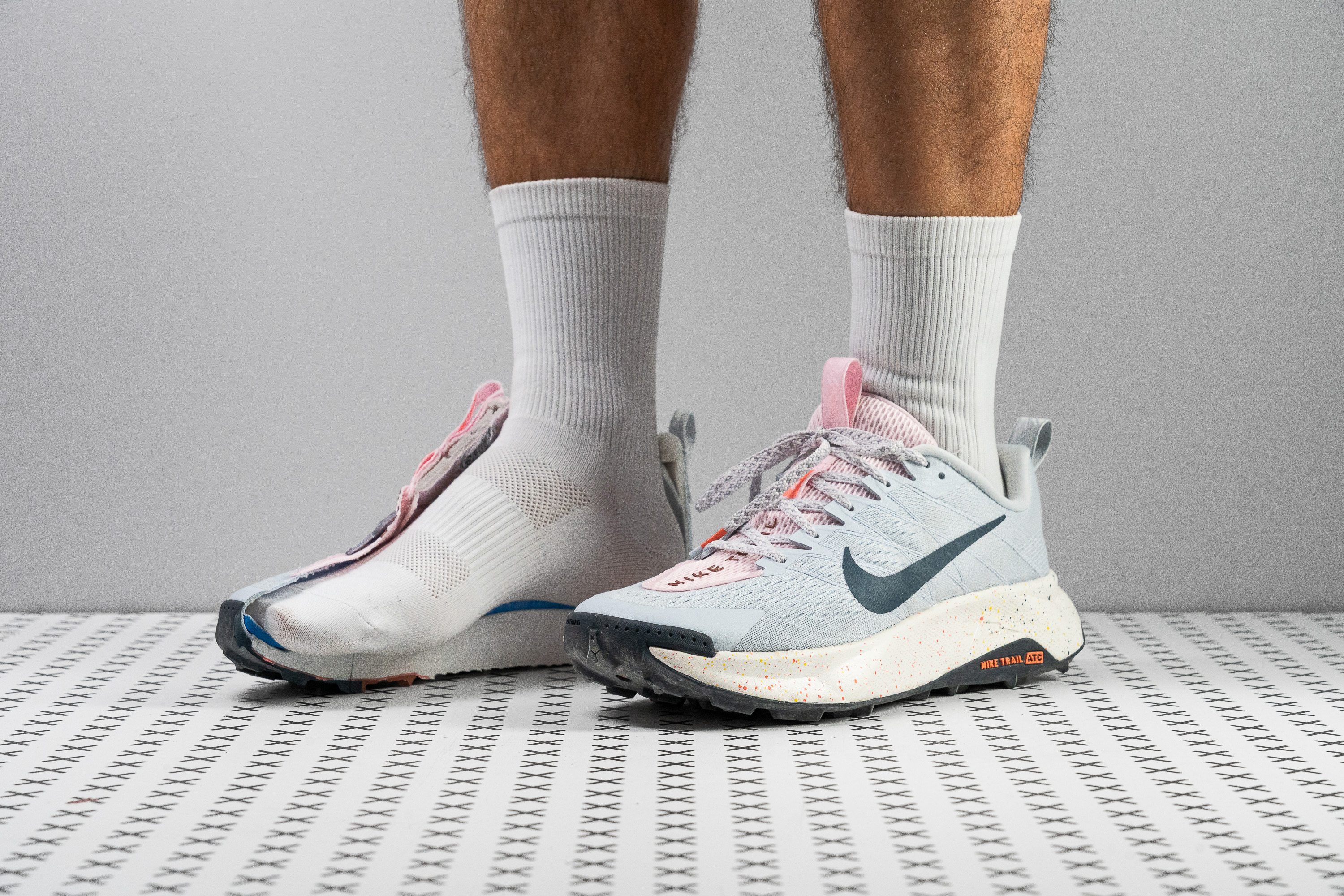










































What makes it the best?
The Nike Wildhorse 10 took good care of our feet as we ran through mountains and rocky trails with its protective stack and rock plate. Our lab numbers show that its well-cushioned yet structured forefoot and spacious fit prevent any additional strain to our rigid big toe. Therefore, it’s our top trail shoe among hallux rigidus running shoes.
Wildhorse 10 features the Rock Shield in the forefoot, which does exactly as its name suggests: shield us from rocks and other debris underfoot. This rock plate adds stiffness to the forefoot, which eliminates any unwanted excessive movement that may cause further pain. Our bend test shows it needs 15.0N to reach 30 degrees, slightly above the 14.5N average.
The ReactX midsole’s generous 38.3/27.4 mm cushioning offers plush comfort to our muscles. The foam itself reduces the forces of each touchdown, proven by its high 144/105 SA ratings, reducing load to our joints and relieving our big toes from strain.
The toebox feels incredibly comfortable, and we could run with our toes completely free from any hindrances. We measured the toebox with an above-average width of 75.4 mm and height of 28.0 mm.
Unfortunately, all these features brought the shoe's weight up to 11.0 oz (312g), 8.0% heavier than average. Runners who want less load on their feet should find a lighter companion on the trails.
Pros
- Cushion-packed midsole
- Modernized upper
- Ideal for heel strikers
- Better build quality
- Bold new look with better finish
- Versatile
- Improved energy return
- Forefoot rock plate
Cons
- Still too heavy
- Mesh upper is fragile
- Brutal price hike
- Less agile than predecessors
This guide is here to educate and discuss various shoe features that may help when dealing with Hallux rigidus or big toe arthritis. Given the nature of this condition, it is imperative to visit a specialist (an orthopedist, foot and ankle surgeon, or pedothrist) who will dig deeper and create a rehabilitation plan, which may or may not include a surgical intervention.
Big toe arthritis or hallux rigidus in runners
This condition is known as big toe arthritis, hallux rigidus, big toe osteoarthritis, or stiff big toe. Hallux rigidus refers to a degenerative arthritis of the first metatarsophalangeal joint. It is often characterized by the growth of bone spurs or dorsal osteophytes on the top (dorsal side) of the first MTP joint. The main symptom of hallux rigidus is stiffness of the big toe and, therefore, limited movement. Pain is also common.
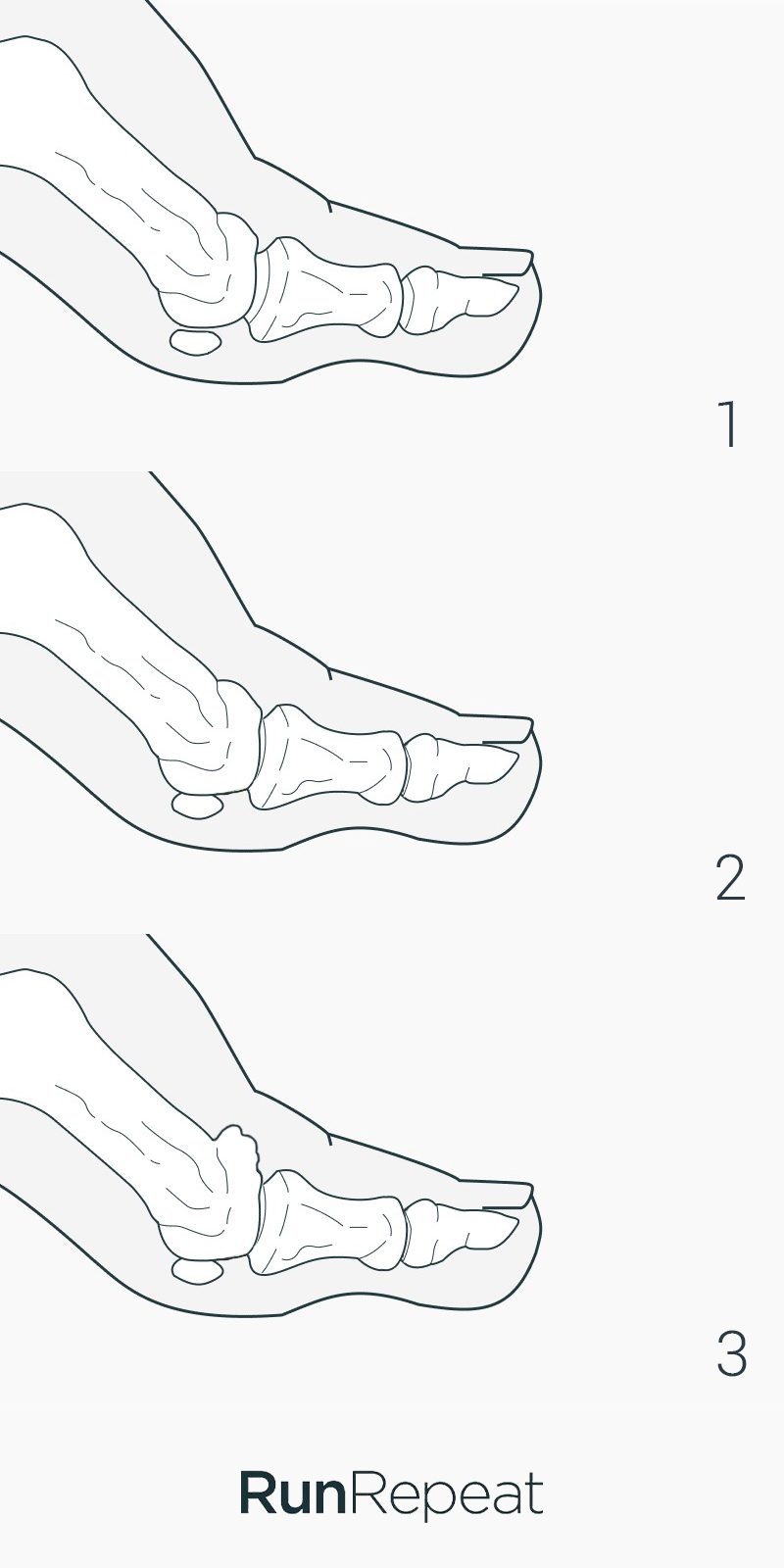
Illustration of the development of hallux rigidus: 1) normal anatomy at the hallux metatarsophalangeal joint; 2) reduction of the joint space and a limitation of dorsiflexion; 3) advanced hallux rigidus with dorsal osteophyte, narrowing of the joint space, and subcortical irregularities
What this actually means is that runners can’t bend or lift the big toe.
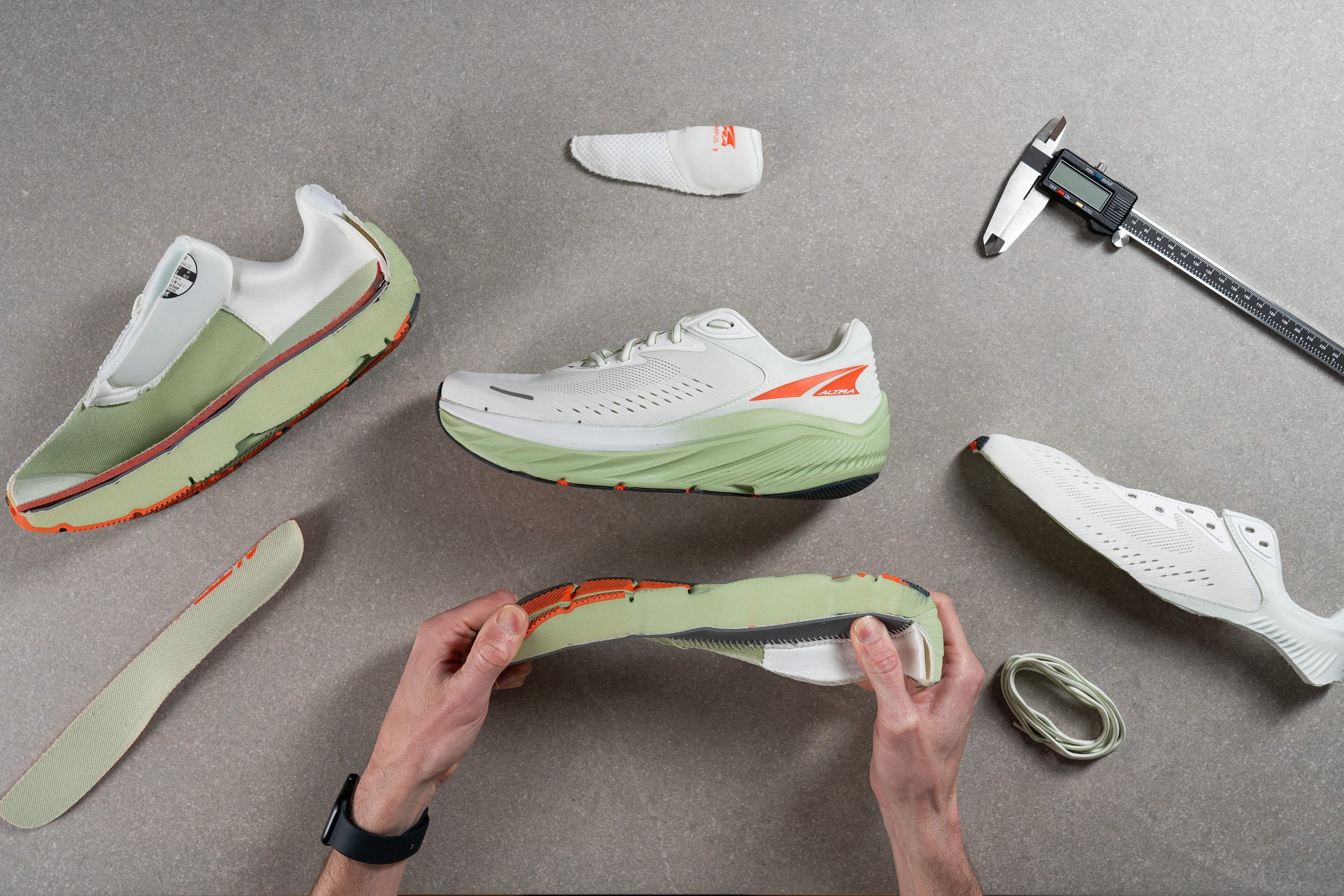
In a study that looked at patients with hallux rigidus and recorded them while walking, it was shown that these patients have a longer stance phase (spend more time with the affected foot on the ground), and that their overall gait is affected because the big toe can’t bend properly at the toe-off and their arch flattens. Compensations happen as well, so other parts of the foot, like the forefoot and hindfoot, move less or in odd ways.
Hallux rigidus vs hallux limitus
Hallux rigidus is a term used to describe big toe joints with nearly no movement, while hallux limitus describes limited motion of the big toe joint. Basically, hallux limitus is an early stage of big toe osteoarthritis, and it can progress to hallux rigidus without treatment or rehab.
 Hallux limitus is described as functional pain due to soft tissue tightness or a long and elevated first metatarsal, while hallux rigidus is described as pain due to an arthritic joint.
Hallux limitus is described as functional pain due to soft tissue tightness or a long and elevated first metatarsal, while hallux rigidus is described as pain due to an arthritic joint.
5 features of running shoes for hallux rigidus
Scientific research has shown a link between ill-fitting footwear and foot anomalies on numerous occasions. It’s imperative to find proper footwear for your feet and your foot conditions. Here are 5 things we recommend looking for in running shoes for hallux rigidus:
- Stiffer platform, especially the forefoot rocker. We recommend platforms that need more than 15N of force to be bent at the forefoot.
- Rockered platform, especially at the forefoot. Some running shoes on our list have a very mild forefoot curvature. This specifically applies to Altra and Topo models, which have toeboxes whose widths and shapes outshine the rest.
- Little to no toe spring if your condition is severe. Some toe spring is OK if it is not painful for you (which most likely means you have hallux limitus or lower grades of hallux rigidus).
- Wide toebox that offers enough room for your toes. We recommend more than 71 mm in the toebox at the big toe and at least 93 mm where the shoe is the widest.
- High toebox is something that those with bone spurs should prioritize. We recommend at least 28 mm of vertical clearance.
We will cover each feature in greater detail below.
Minimalist or cushioned: a dilemma
For a running shoe to be stiff and rockered, it has to be cushioned, often even maximalist. But, some runners have found comfort in minimalist running shoes with high-volume toeboxes. How does this make sense?
Minimalist running shoes have no stabilizing technologies; they are very flexible and usually feature a zero or a low heel drop. This means that the feet have to work much more. Depending on the diagnosis and current condition (hallux rigidus grade or hallux limitus), some runners can afford that extra work, with the purpose of strengthening the foot muscles.
Going down this path may offer pain/discomfort relief and is something best double-checked with a specialist.
Why a stiff forefoot is a must for hallux rigidus
Stiffness of the forefoot rocker is accomplished by having a lot of cushioning and/or having a plate that makes the shoe even stiffer. It needs to be stiff because this stiffness reduces the stress on the big toe joint.
Runners who have hallux rigidus often experience discomfort and pain in shoes with very flexible platforms because the requirement for dorsiflexion at propulsion is increased. Stiffer forefoots simply feel much better.
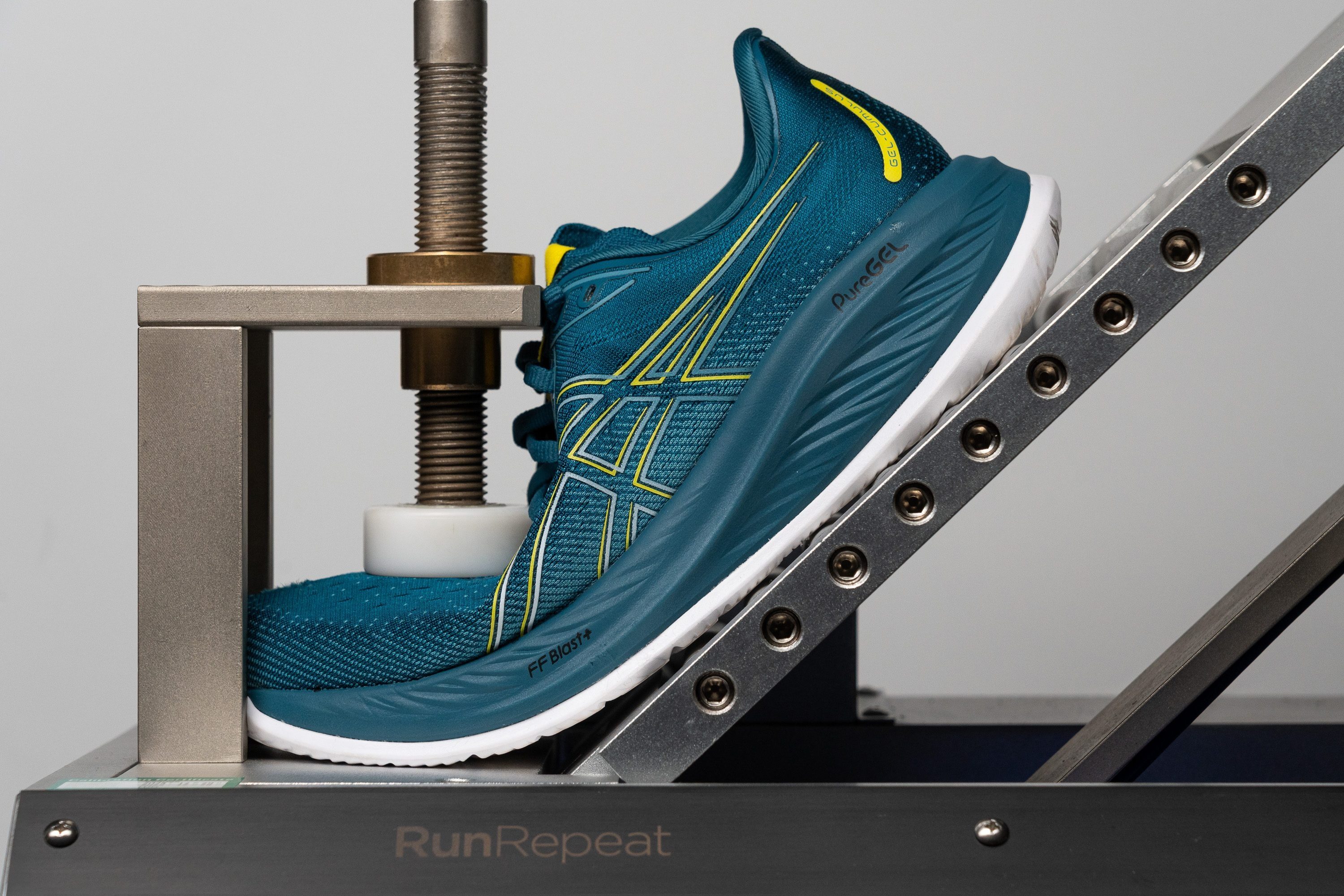
For hallux rigidus, we recommend running shoes that require a force of at least 15N to be bent to 30 degrees after adjusting for the rocker.
Rocker: YES, toe spring: NO
First, we should elaborate on the difference between the forefoot rocker and the toe spring, as it may be confusing for some.
Rocker is a curved geometry of the sole on the bottom side. Looking at the shoe’s platform, it can lie almost flat on the ground, it can have a very aggressive rocker (curve), and it can fit somewhere in between with different rocker degrees. The rocker can start closer to the tip of the shoe or under the ball of the foot, or even further away towards the midfoot.
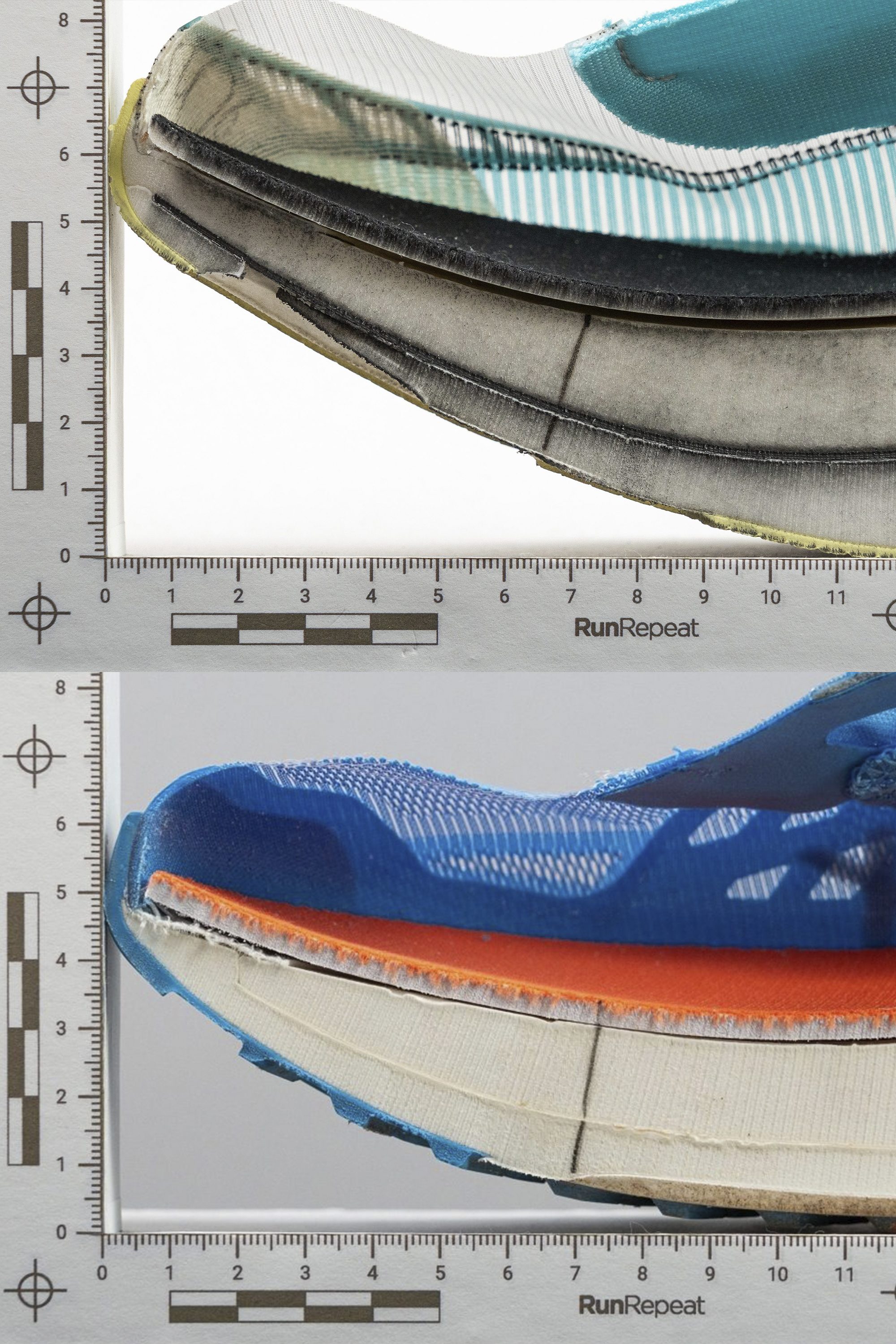
Toe spring, on the other hand, is the curve of the forefoot on the inside, where it’s in contact with the foot. Toes can lie on the almost flat surface or the platform at the forefoot can be quite curved, creating a toe spring.
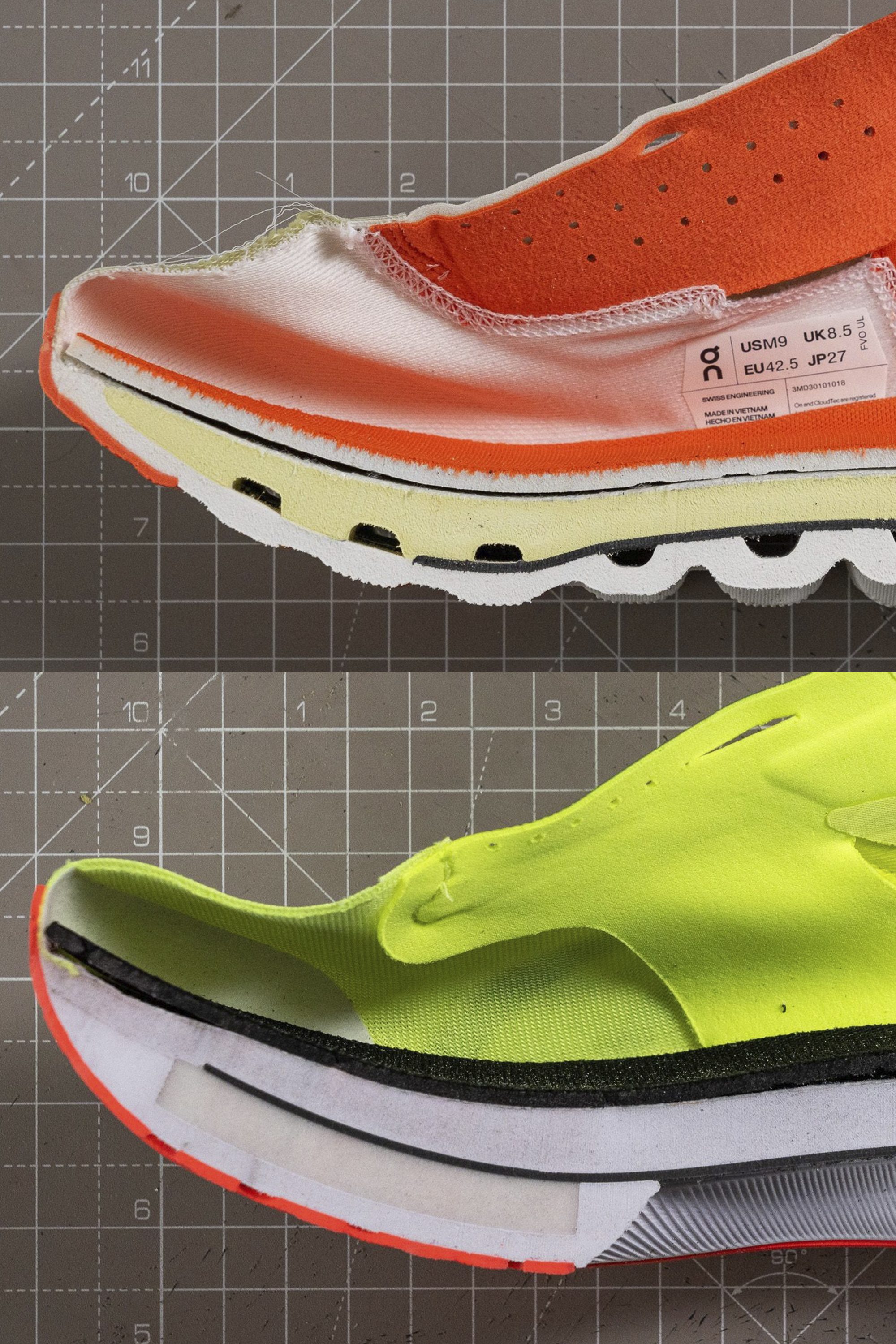
|
If you’re experiencing big toe arthritis, we recommend running shoes with a forefoot rocker. The rocker helps with forward motion and takes over some of the work from the big toe—it helps diminish painful dorsiflexion. We don’t recommend running shoes with toe springs, as those can be quite painful. Hallux rigidus is all about the lack of movement or painful movements, and a toe spring forces your big toe to be lifted at all times. |
You may be OK with a mild toe spring if that position is not painful for you, which most likely means your hallux rigidus is of a lower grade or you’re experiencing hallux limitus. Also a very mild rocker curvature can be ok if you need a really wide toebox. No other brands offer what Altra and Topo do, so their shoes can be hallux-rigidus-friendly if they fulfill all (or most of) the other criteria.
If you’re curious about the rocker technology, we wholeheartedly recommend our in-depth guide All you need to know about rockered running shoes.
Toebox volume in running shoes for big toe arthritis
Again, backed by scientific research, runners who have hallux rigidus are better off with running shoes that don’t put pressure on their toes, from the sides or from the top. This means that you should find running shoes with toeboxes that are roomy enough for you.
We can’t say “wear only Topo or Altra” because there are runners with narrow feet who would simply swim and slide in those. But, you should choose a toebox that’s wider/taller than what you’re most likely used to because:
- A wider toebox will eliminate the compression of the big toe. When compressed, osteophytes can rub the joint.
- A taller toebox eliminates the pressure put on the prominent osteophytes.
Runners with no osteophytes also reported that a wider and a taller toebox feel better and decided to keep using such shoes.
Based on all this evidence and our lab data, we recommend running shoes with a:
- Toebox that’s at least 71 mm wide at the big toe (you may need much wider depending on the width of your forefoot)
- Shoe that’s at least 93 mm wide. This recommendation comes from the location where we measure the shoe width: where it’s the widest. This is exactly where the metatarsals end and phalanges start. We want no pressure in that area as the shoe would press directly on the big toe joint!
- Toebox that’s at least 28 mm high.
We measure the width and the height of the toebox by creating a gel mold of the shoe’s interiors and then measuring its volume
When the mold is ready, we measure the width of the shoe where it is the widest, the width of the toebox at the big toe, and the height of the toebox at the big toe.
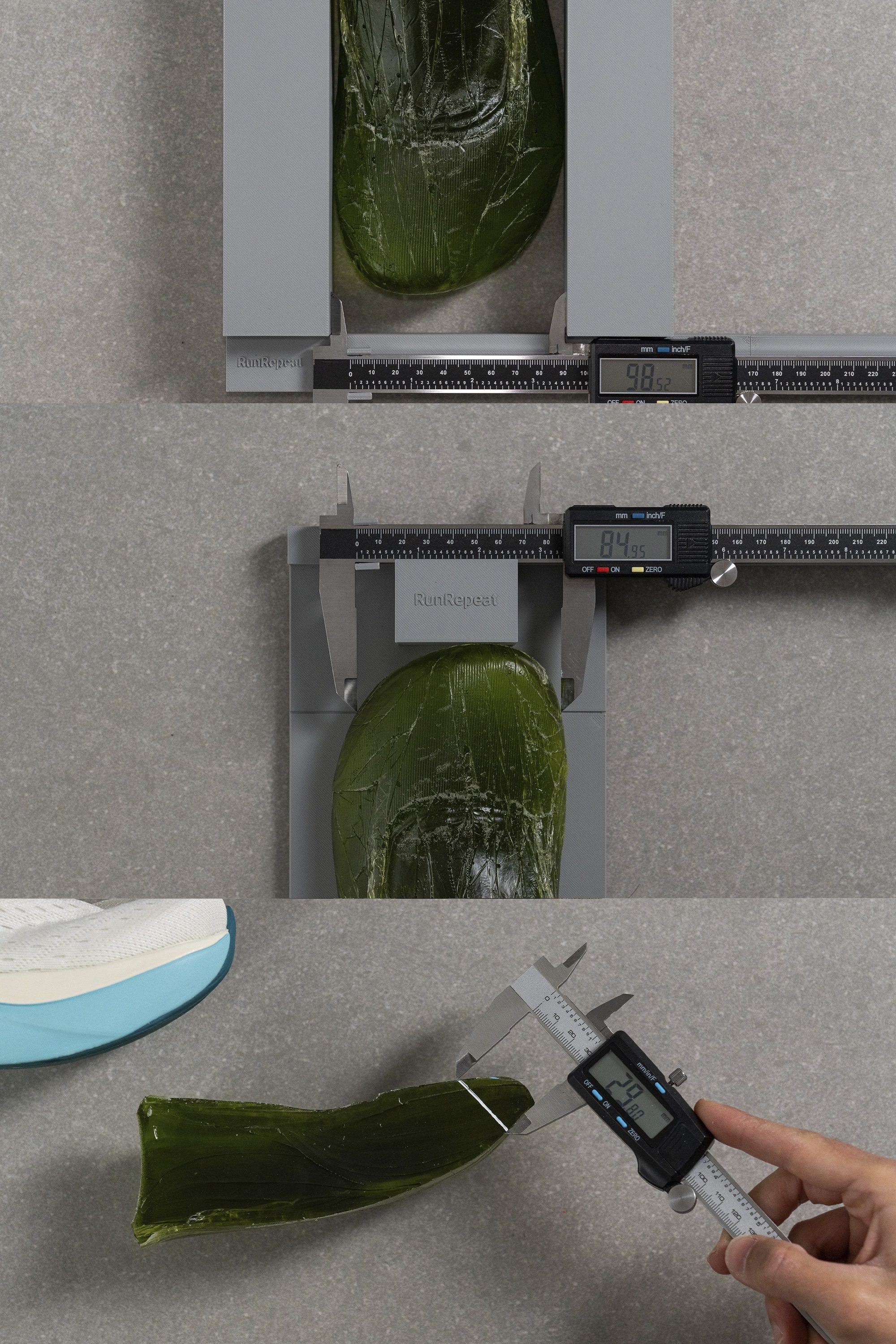
If your bone spurs are very prominent, consider getting running shoes with very tall toeboxes. Here’s the shortlist:
Inserts for hallux rigidus
There are different insoles on the market that may help with discomfort and pain caused by hallux rigidus, like Morton toe insoles or carbon fiber insoles. You can give them a try before buying a new pair of running shoes to see how they fit and whether you’re experiencing any improvement. However, these can only help with stiffness, not with toebox width, height, or rocker.
Hallux rigidus treatment options
The first thing you can and should do is consult a specialist. There are different causes of big toe pain and only a certified specialist can and should set a diagnosis and disucss a rehabilitation plan.
Overall, treatment methods for hallux rigidus are conservative or surgical. If you address the condition on time, you may be able to avoid surgery. Some of the conservative methods are: joint mobilization, stretching, different exercises, wearing orthotics, shoe-stiffening inserts, getting injections of hyaluronic acid, and buying appropriate footwear.
The idea behind the conservative approach is to reduce the motion of the big toe, reduce the stress on the joint, and limit irritation from the dorsal osteophytes.
When it comes to surgical interventions, one study has shown that a joint-preserving operation in grade I and II hallux rigidus led to persistent pain reduction and patient satisfaction. Cheilectomy is basically a joint-sparing treatment for the early stages of hallux rigidus (grades I, II, and III). It involves a resection of <30% of the dorsal metatarsal head and a removal of the intraarticular loose bodies and osteophytes localized in the metatarsal head and proximal phalanx. A few more notes on cheilectomy:
- Complication rates are low, 0 to 3%
- It’s not a permanent solution to the problem as it does not prevent the progression of the hallux rigidus
- Helps runners get back to their daily activities quicker
- A study that looked at the 7-year-long post-op period found that the average improvement in pain relief was 88%, while 95% of all patients said they would do the same procedure again
Other surgical options include Moberg osteotomy, arthrodesis, arthroplasty, and arthroscopy, which are well described in this study. Of course, we recommend you look for a specialist sooner rather than later to address this foot condition on time and with less hassle.
Grades of hallux rigidus
Grade 0
- Dorsiflexion: 40° to 60° and/or 10% to 20% loss compared with the normal side.
- Symptoms: no pain, only stiffness and loss of motion on examination.
Grade 1
- Dorsiflexion: 30° to 40° and/or 20% to 50% loss compared with the normal side.
- Symptoms: Mild or occasional pain and stiffness, pain at extremes of dorsiflexion and/or plantar flexion.
Grade 2
- Dorsiflexion: 10° to 30° and/or 50% to 75% loss compared with the normal side.
- Symptoms: Moderate-to-severe pain and stiffness that may be constant; pain occurs just before maximum dorsiflexion and maximum plantar flexion.
Grade 3
- Dorsiflexion: ≤ 10° and/or 75% to 100% loss compared with the normal side. There is a notable loss of metatarsophalangeal plantar flexion as well (often ≤ 10° of plantar flexion).
- Symptoms: Nearly constant pain and substantial stiffness at extremes of range of motion, but not at mid-range.
Grade 4
- Dorsiflexion: Same as in grade 3.
- Symptoms: Same as in grade 3, but there is definite pain at mid-range of passive motion.
Good-to-know about hallux rigidus
- Big toe arthritis is the 2nd most common condition affecting the first MTP joint, right after hallux valgus (bunions).
- Women are 2x more likely to experience hallux rigidus than men.
- Having other conditions can significantly increase the risk of having hallux rigidus: bunions 4x higher risk, gout attacks 3.9x higher risk, knee arthritis 1.7x higher risk.
- Up to 55% of people with hallux rigidus get adequate pain relief without surgical intervention.
Sources
- https://pubmed.ncbi.nlm.nih.gov/32310479/
- https://www.ncbi.nlm.nih.gov/books/NBK556019/
- https://bmcmusculoskeletdisord.biomedcentral.com/articles/10.1186/s12891-021-04666-y
- https://pubmed.ncbi.nlm.nih.gov/38884172/
- https://pubmed.ncbi.nlm.nih.gov/26320555/
- https://pubmed.ncbi.nlm.nih.gov/33559617/
- https://pubmed.ncbi.nlm.nih.gov/33160837
- https://pubmed.ncbi.nlm.nih.gov/28567339
- https://pubmed.ncbi.nlm.nih.gov/17972321/
- https://pubmed.ncbi.nlm.nih.gov/19306008/
- https://jfootankle.com/JournalFootAnkle/article/download/1579/1793
- https://pubmed.ncbi.nlm.nih.gov/22735316/
- https://pubmed.ncbi.nlm.nih.gov/23606380/
